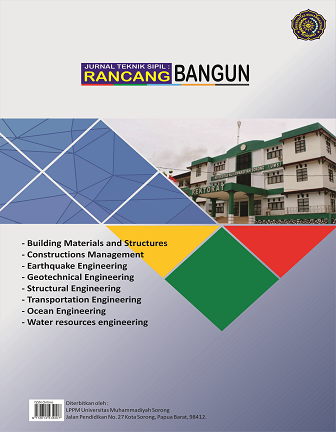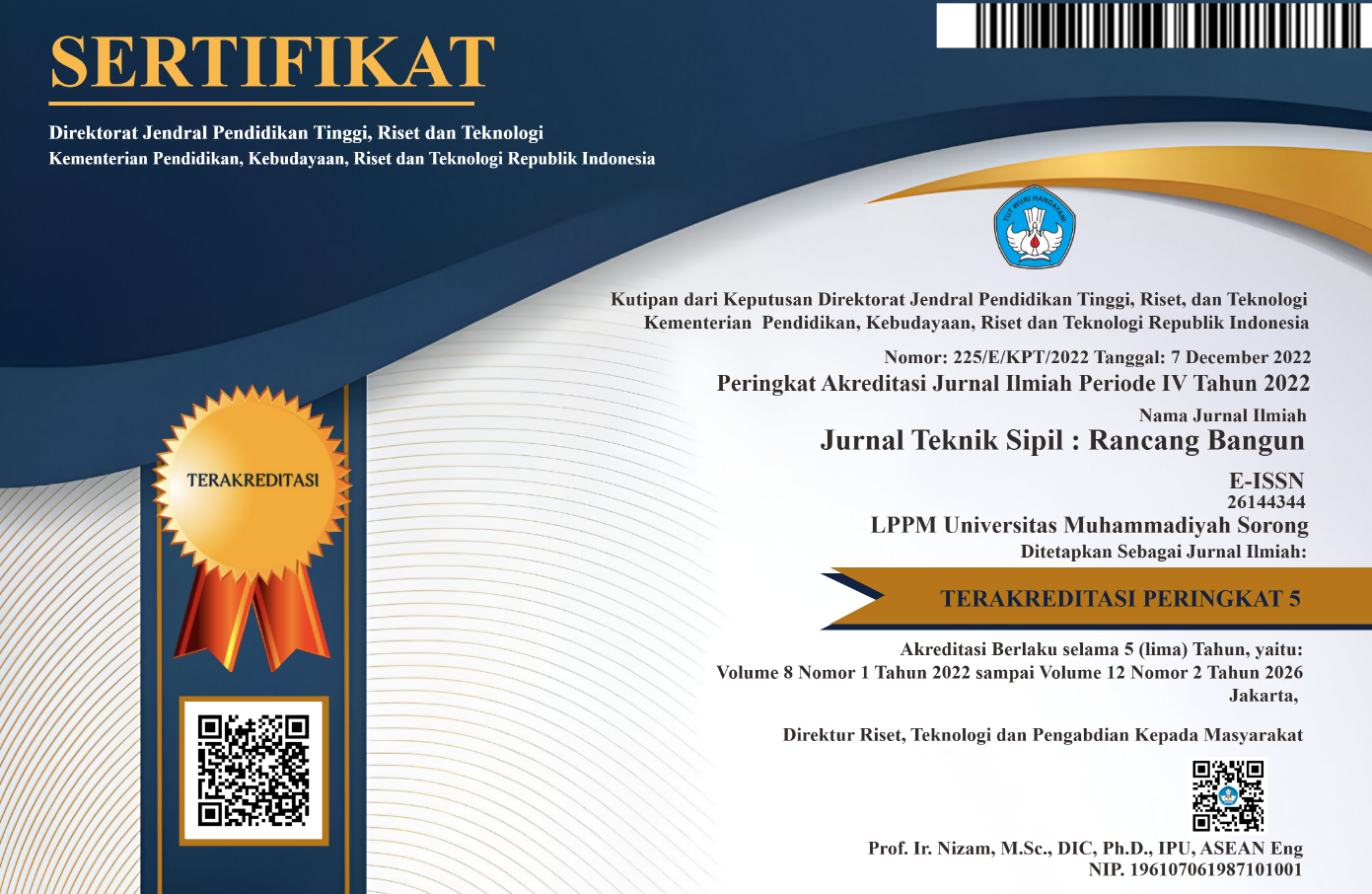STRATEGI PERCEPATAN PROYEK DENGAN METODE CRASHING PADA PEMBANGUNAN DRAINASE DI PEMUKIMAN PADAT PENDUDUK
DOI:
https://doi.org/10.33506/rb.v9i2.2632Keywords:
Percepatan, crashing, pemukiman padat, strategiAbstract
Pembangunan sebuah proyek konstruksi harus memperhatikan faktor resiko di sekitar lokasi. Pembangunan drainase di Pekalongan adalah salah satu contohnya. Demografis yang padat memerlukan strategi tersendiri untuk mengatasinya. Percepatan proyek direkomendasikan untuk menjadi solusi alternatif penyelesaian. Metode yang diadopsi adalah percepatan crashing, dimana pekerjaan yang dianalisis adalah pekerjaan kritis. Data yang dibutuhkan adalah RAB, AHSP, dan Kurva-S. Pekerjaan kritis didapatkan dengan bantuan metode CPM yang divisualisasikan aplikasi Microsoft Project 2019. Waktu percepatan proyek dipilih 1 hari, 7 hari, dan 30 hari. Hasil menunjukan bahwa percepatan waktu 30 hari merupakan pilihan yang paling tepat dengan tambahan biaya Rp 33.517.144 disimpulkan dari biaya slopenya. Percepatan waktu dari durasi awal 180 hari menjadi 150 hari dapat dihandalkan sebagai acuan proyek serupa. Sehingga permasalahan proyek yang mungkin timbul di daerah padat penduduk dapat diminmalisir.
References
Aliyu, A. (2013). Project Management using Critical Path Method (CPM): A Pragmatic Study. Global Journal of Pure and Applied Sciences, 18(3–4), 197–206. https://doi.org/10.4314/gjpas.v18i3-4.11
Amalia, N. V., Fahmi, I. N., & Luthfianto, S. (2018). Penerapan Program Microsoft Project 2010 Untuk Proses Produksi Bed 1 Crank Pada Perusahaan Cv. Target. Seminar Nasional IENACO -, 1, 200–205. https://publikasiilmiah.ums.ac.id/handle/11617/10667
Anyanwu, C. I. (2013). Project Cost Control in the Nigerian Construction Industry. International Journal of Engineering Science InventionISSN (Online): 2319 –6734, ISSN (Print): 2319 –6726www.Ijesi.Org || Volume 2 Issue 12 || December. 2013 || PP.65-71, 2(12), 65–71.
Arabpour Roghabadi, M., & Moselhi, O. (2019). Optimized acceleration in linear scheduling. Proceedings, Annual Conference - Canadian Society for Civil Engineering, 2019-June(5).
Bakry, I., Moselhi, O., & Zayed, T. (2014). Optimized acceleration of repetitive construction projects. Automation in Construction, 39, 145–151. https://doi.org/10.1016/j.autcon.2013.07.003
Dinas Perumahan Rakyat dan Kawasan Pemukiman dan Lingkungan Hidup. (2023). Dinas Perumahan Rakyat dan kawasan permukiman. In 26/10/2020. http://si.disperakim.jatengprov.go.id/umum/detail_kondisi_geo/20
Dinas PU Bina Marga dan Cipta Karya Provinsi Jawa Tengah. (2022). Harga Satuan Pekerjaan (Hsp) Konstruksi Bidang Cipta Karya Dan Perumahan Edisi Ke-1 Tahun 2022 Kab. Pekalongan. http://maspetruk.dpubinmarcipka.jatengprov.go.id/harga_satuan/hspk#
Dlamini, M., & Cumberlege, R. (2021). The impact of cost overruns and delays in the construction business. IOP Conference Series: Earth and Environmental Science, 654(1), 012029. https://doi.org/10.1088/1755-1315/654/1/012029
Garg, A. (2016). Project Crashing Algorithm. Research Gate, November. https://www.researchgate.net/publication/310493482
Giri Aspia Ningrum, F., & Hartono, W. (2017). Penerapan Metode Crashing Dalam Percepatan Durasi Proyek Dengan Alternatif Penambahan Jam Lembur Dan Shift Kerja (Studi Kasus: Proyek Pembangunan Hotel Grand Keisha, Yogyakarta). 583. https://doi.org/https://doi.org/10.20961/mateksi.v5i2.36873
Hasanawi, A., Masturi, H., & Hasanawi, A. (2019). Improvement of Community Governance to Support Slum Upgrading in Indonesia. Jurnal Perencanaan Pembangunan: The Indonesian Journal of Development Planning, 3(3), 347–358. https://doi.org/10.36574/jpp.v3i3.88
Hussain, S., Zhu, F., Ali, Z., & Xu, X. (2017). Rural Residents’ Perception of Construction Project Delays in Pakistan. Sustainability, 9(11), 2108. https://doi.org/10.3390/su9112108
Iluk, T., Ridwan, A., & Winarto, S. (2020). Penerapan Metode CPM Dan PERT Pada Gedung Parkir 3 Lantai Grand Panglima Polim Kediri. Jurnal Manajemen Teknologi & Teknik Sipil, 3(2), 162. https://doi.org/10.30737/jurmateks.v3i2.1054
Ir. H. Nur Sahid, M. M. M. T. (n.d.). Teknik Pelaksanaan Konstruksi Bangunan. Muhammadiyah University Press. https://books.google.co.id/books?id=a7VVDwAAQBAJ
Lim, C. ., & Mohamed, M. Z. (1999). Criteria of project success: an exploratory re-examination. International Journal of Project Management, 17(4), 243–248. https://doi.org/10.1016/S0263-7863(98)00040-4
Luo, L., He, Q., Jaselskis, E. J., & Xie, J. (2017). Construction Project Complexity: Research Trends and Implications. Journal of Construction Engineering and Management, 143(7). https://doi.org/10.1061/(ASCE)CO.1943-7862.0001306
McGrew, W. C. (1994). The Third Chimpanzee: The Evolution and Future of the Human Animal. Jared Diamond. The Quarterly Review of Biology, 69(3), 431–432. https://doi.org/10.1086/418730
Moselhi, O., Bakry, I., & Alshibani, A. (2016). Accelerating repetitive construction projects: with uncertainty and contractors’ judgment. Canadian Journal of Civil Engineering, 43(11), 949–957. https://doi.org/10.1139/cjce-2014-0347
Priyanto, B., Sahid, M. N., Solikin, M., & Faruqi, J. Al. (2022). Investigation of Critical Risk Factors and Level of Risk for Environmentally damage induced by house projects. Caspian Journal of Environmental Sciences, 20(2), 413–421. https://doi.org/10.22124/CJES.2022.5589
Rahman, I. A., Memon, A. H., Nagapan, S., Latif, Q. B. A. I., & Azis, A. A. A. (2012). Time and cost performance of costruction projects in southern and cenrtal regions of penisular Malaysia. 2012 IEEE Colloquium on Humanities, Science and Engineering (CHUSER), March, 52–57. https://doi.org/10.1109/CHUSER.2012.6504280
Sahid, M. N., Mulyono, G. S., Nuryanto, A. S. J., & Abdurrosyid, J. (2020). Evaluasi Pengendalian Waktu dan Produktivitas Tenaga Kerja Pelaksanaan Proyek Pembangunan Gedung Parkir Menggunakan Metode Jaringan Kerja Critical Path Methode (CPM) (Studi Kasus : Gedung Parkir Balai Kota Semarang). Dinamika Teknik Sipil: Majalah Ilmiah Teknik Sipil, 13(2), 71–79. https://doi.org/10.23917/dts.v13i2.13057
Sahu, K., & Sahu, M. (2014). Cost & Time and Also Minimum Project Duration Using Alternative Method. International Review of Applied Engineering Research, 4(5), 403–412. http://www.ripublication.com/iraer.htm
Simanjuntak, M. R. A., & Rihatmoko. (2019). Identifikasi Faktor-Faktor Penting Manajemen Konstruksi Pada Proyek “Airport Extension” Bandara Internasional Ngurah Rai, Bali. Prosiding Seminar Nasional Teknik Sipil 2019, 252–257. https://publikasiilmiah.ums.ac.id/
Ssemwogerere, K. (2018). A case for acceleration rather than extension of time on construction projects in Uganda. 2nd International Conference on Construction and Project Management, 15(9), 192–195. https://iiste.org/Journals/index.php/CER/article/view/44512
Vyas, R. S., & Mechanical. (2013). Scheduling Project Management Using Crashing CPM Network to get Project completed on Time. International Journal of Engineering Research & Technology (IJERT), 2(2), 1–13. https://doi.org/http://doi.org/10.13140/RG.2.2.10891.13607
Yang, J.-B., & Teng, Y.-L. (2017). Theoretical development of stochastic delay analysis and forecast method. Journal of the Chinese Institute of Engineers, 40(5), 391–400. https://doi.org/10.1080/02533839.2017.1336115
Downloads
Published
How to Cite
Issue
Section
License
Copyright (c) 2023 Tsulis Iq'bal Khairul Amar, Fresti Febria Astuti, Vivi Tri Wulandari

This work is licensed under a Creative Commons Attribution-ShareAlike 4.0 International License.






